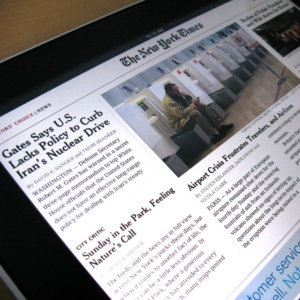Beyond Forecasting: Creating New Strategic Narratives
In turbulent markets, it can be hard for established companies to choose new strategic directions. But by rethinking the past and present and reimagining the future, managers can construct strategic narratives that enable innovation.
One of the great challenges for organizations in the current economy is making strategy under the uncertainties posed by turbulent environments, intensified competition, emerging technologies, shifting customer tastes and regulatory change. Executives often know they must break with the status quo, but there are few signposts indicating the best way forward.
A core assumption in much of strategic management research is that more accurate forecasts of future competitive actions or the future value of certain business capabilities will lead to strategic success.1 Executives have long been exhorted to conduct analyses of internal and external environments and construct scenarios of the future. However, seeing strategy in this way has some serious weaknesses. It assumes that accuracy can be achieved through rigorous analysis and conscientious efforts to overcome individual biases in perception. It also assumes that the process will be relatively frictionless and primarily analytical.
There is an important tension at work here. Because the future is essentially unknowable, leaders must rely on the past for information and insight. Moreover, given that the future is unknown, there are likely to be differences and conflicts within the organization about what that future might hold. Such conflicts can impede progress on the development and execution of new strategies — especially innovative strategies that depart significantly from a company’s current approach to the market.
Studies have pointed to the “abject failure”2 of most forecasting efforts to attain the desired precision. While strategy researchers tell managers they should project into the future, we tell them little about how to do this. As observed by an executive at CommCorp (a pseudonym for a communications technology corporation that we studied in 2002, shortly after the bursting of the Internet bubble):
Who today in this marketplace has accurate data? I mean, nobody, literally nobody. It is very hard. You have a gazillion points right now where, you know, everybody — economists, analysts, companies — fails to forecast accurately … so forecasting is very difficult, or you can say impossible, because [of the] dramatic change.
References
1. See, for example, J.B. Barney, “Strategic Factor Markets: Expectations, Luck, and Business Strategy,” Management Science 32, no. 10 (October 1986): 1231-1241; J.B. Barney, “Firm Resources and Sustained Competitive Advantage,” Journal of Management 17, no. 1 (March 1991): 99-120; M.A. Peteraf, “The Cornerstones of Competitive Advantage: A Resource-Based View,” Strategic Management Journal 14, no. 3 (March 1993):179-191; and C.K. Prahalad and G. Hamel, “The Core Competence of the Corporation,” Harvard Business Review 68, no. 3 (May-June 1990): 79-91.
2. M.L. Barnett, W.H. Starbuck and R.N. Pant, “Which Dreams Come True? Endogeneity, Industry Structure and Forecasting Accuracy,” Industrial & Corporate Change 12, no. 4 (August 2003): 653-672.
3. The New York Times, “Innovation” (New York, N.Y.: New York Times, Mar. 24, 2014), 41-43 accessed via www.scribd.com.
4. See for example, R. Cheng, “Kindle Fire HD: Amazon’s Anti-Apple Profit Engine,” Sept. 6, 2012, cnet.com; and F. Manjoo, “Why Did Amazon Make a Phone? A Conversation With Jeff Bezos,” June 19, 2014, bits.blogs.nytimes.com.
5. See S. Jacobs, “The Amazon Fire’s Fanciest Features Fail to Impress,” MIT Technology Review, Aug. 5, 2014. See also G.A. Fowler, “Amazon Fire Phone Review: Full of Gimmicks, Lacking Basics,” Wall Street Journal, July 23, 2014; and T. Duryee, “Amazon Fire Phone Nosedives on Company’s Bestsellers List, Dropping to #61 After Debuting in Top Five,” June 30, 2014, GeekWire.
6. V. Govindarajan and C. Trimble, “The CEO’s Role in Business Model Reinvention,” Harvard Business Review 89, no. 1-2 (January-February 2011): 108-114.
7. H. Mintzberg and J. Lampel, “Reflecting on the Strategy Process,” Sloan Management Review 40, no. 3 (spring 1999): 21-30; and H. Mintzberg and J.A. Waters, “Of Strategies, Deliberate and Emergent,” Strategic Management Journal 6, no. 3 (July-September 1985): 257-272.
i. S. Kaplan and W.J. Orlikowski, “Temporal Work in Strategy Making,” Organization Science 24, no. 4 (July-August 2013): 965-995.


Comment (1)
Raul Bustamante